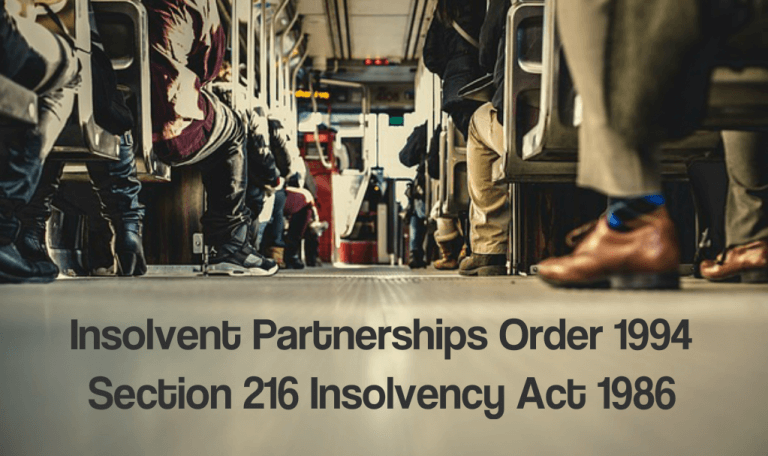Escaping liability in professional partnership insolvencies

… It is possible inadvertently to throw away these defences in the course of the process leading up to administration, a PVA and/or IVAs …
This article describes the run-up to a professional partnership insolvency, and the choices faced by the partners who control the partnership. It then goes on to identify particular issues faced by salaried and fixed share partners, and the opportunities open to them to try to avoid personal liability for the firm’s debts.
The primary driver behind the swathe of LLP conversions during the last ten years, namely the risk of insolvency brought about by a catastrophic negligence claim in excess of the limit of a practice’s professional indemnity insurance, has not really come to pass. In these hard times many firms are instead sinking under the weight of their trading losses, brought about by decreasing turnover, and sometimes aggravated by partners who have seen the writing on the wall and have left, taking clients with them.
Most commonly, salaried and even fixed share partners are not involved in management, and they have either no idea or only a faint perception as to how badly things are going for their firm. The first they may know of a problem is when the equity partners tell them that they are proposing to put the practice into administration and/or pursue a partnership voluntary arrangement (PVA), and/or in some cases individual voluntary arrangements (IVAs). It is quite common for the salaried and fixed share partners to be asked to co-operate in these processes. This invitation needs to be approached with extreme caution.
Very often the equity partners will have had their heads in the sand, hoping for an upturn in work that never comes and/or compassion and time to pay from a growing roster of creditors, who may have become increasingly impatient. A final demand from HMRC in connection with failure to pay PAYE and/or VAT is commonly what prompts the equity partners to consult an insolvency practitioner.
Administration is usually only going to be possible and worthwhile if the firm has a decent business which someone is willing to buy. Client loyalty is a big issue here. In the case of a professional practice, given regulatory issues and the practical point that a professional practice in administration will rapidly lose its clients and goodwill, any administration is almost certainly going to have to involve a “pre-pack”, in other words a sale will have to be agreed with a buyer prior to and be triggered by the commencement of the administration.
Even if a buyer can be found, an administration may provide only very temporary relief for the partners, as they will still have unlimited personal liability for the debts of the firm. The evil day when they have to face up to their liabilities may have been briefly deferred, and the sale of the goodwill of the practice may well have provided some much-needed additional funds, but in most cases there will still be a substantial rump of indebtedness that the partners will have to address (whether or not the firm goes into liquidation).
A PVA may be standalone or may follow an administration. Whether or not preceded by an administration, IVAs may also be required if creditors are trying or threatening to pursue individual partners into bankruptcy. Indeed sometimes, especially in the case of smaller firms, interlocking IVAs are used instead of a PVA. Consideration has to be given as to how the partners’ professional regulatory body will react to a PVA or IVAs, in particular whether that body will permit the partners to continue in practice after a PVA and/or IVAs are in place. Clearly this is crucial and a decision of the regulator must be sought before any steps are taken, otherwise the PVA (and any associated IVAs) will have achieved nothing, particularly if (as is common) they include, as part of the proposal to creditors, a contribution from ongoing profits of the firm over a number of years (with the result that the PVA and/or IVAs fail, and the final outcome is liquidation and/or bankruptcy).
Sometimes therefore, depending on the profession concerned, the equity partners may have to accompany their PVA with a “merger” with another firm, in which they can be “supervised” in their professional work by partners who are not the subject of an insolvency regime (this is particularly common where the practice needs to hold client money).
I put “merger” in inverted commas as more likely than not the partners of the insolvent firm will not be granted much if any status in the firm with which they are merging, often becoming salaried partners or consultants or indeed accepting a lower rank, just to generate income to live and to enable them to make any agreed ongoing contribution to their PVA/IVAs.
Whether the firm has to “merge” or not, salaried and fixed share partners will no doubt wish to consider their prospects for advancement (and their continuing exposure to future liabilities) in a firm that has suffered such trauma and/or in which some or all of the partners may be paying off creditors for some time. Particularly if the firm is able to continue without “merging”, salaried and fixed share partners may wish to consider whether they should (a) ask to be given another title and not be held out as partners going forward, or (b) find a job elsewhere. Either way, the purpose will be to avoid incurring potential liability for further debts that may arise in the future. In order for this to work, effective notice has to be given to everyone who has dealings with the firm, and there is a right and a wrong way to do this.
A PVA with or without IVAs may, depending on the terms proposed, put an end to the salaried and fixed share partners’ exposure to liability for the firm’s debts. But creditors may not accept the PVA/IVAs, or if they do the PVA/IVAs may fail because the firm and/or the partners may be unable in the final event to comply with the agreed terms.
One way or another, salaried and fixed share partners may well be exposed to creditor claims. Although they may well not be true partners (which can only be determined after a careful review of their precise rights and obligations) they may be liable to creditors anyway under section 14(1) of the Partnership Act 1890 (holding out). Such liability depends not only on whether they have been held out as partners but also on whether the creditors concerned have relied on them when advancing credit to the firm. This is a very important potential defence. By adopting the right strategy it is possible to use this defence to keep creditors at bay for a long time or indeed to deflect them entirely.
Other technical (but nonetheless highly effective) defences are likely to be available to fixed share and salaried partners against HMRC and landlords.
It is most important therefore that salaried and fixed share partners do not do anything that will jeopardise these defences. It is possible inadvertently to throw away these defences in the course of the process leading up to administration, a PVA and/or IVAs, and salaried and fixed share partners should therefore obtain specialist and independent legal advice at the very first intimation of the firm’s insolvency, otherwise they may be at risk of falling into a number of traps which will result in them being dragged along by the equity partners into personal insolvency that might otherwise have been avoided.






